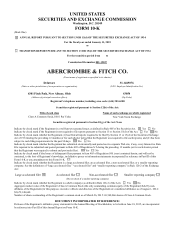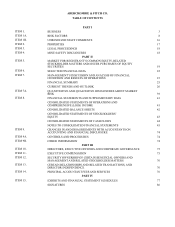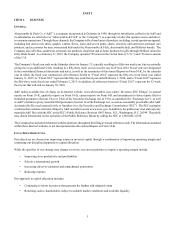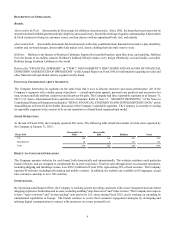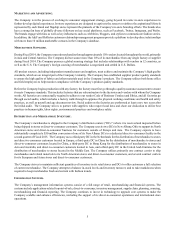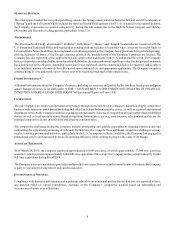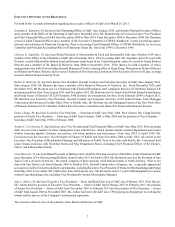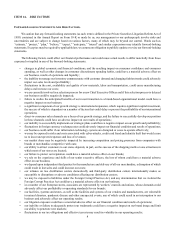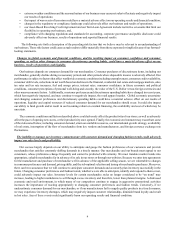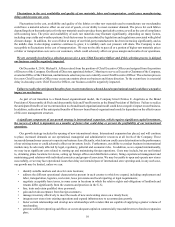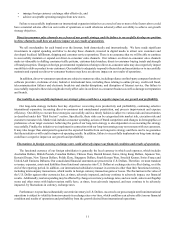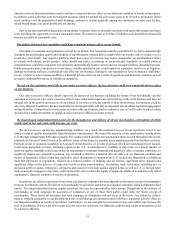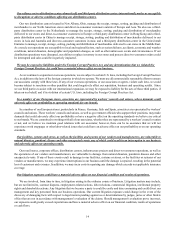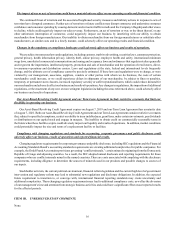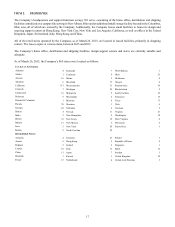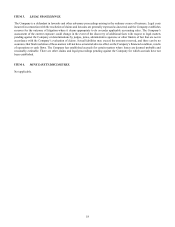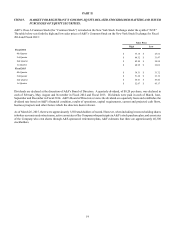Abercrombie & Fitch 2014 Annual Report Download - page 10
Download and view the complete annual report
Please find page 10 of the 2014 Abercrombie & Fitch annual report below. You can navigate through the pages in the report by either clicking on the pages listed below, or by using the keyword search tool below to find specific information within the annual report.
10
Fluctuations in the cost, availability and quality of raw materials, labor and transportation, could cause manufacturing
delays and increase our costs.
Fluctuations in the cost, availability and quality of the fabrics or other raw materials used to manufacture our merchandise
could have a material adverse effect on our cost of goods, or our ability to meet customer demand. The prices for such fabrics
depend largely on the market prices for the raw materials used to produce them, particularly cotton, as well as the cost of compliance
with sourcing laws. The price and availability of such raw materials may fluctuate significantly, depending on many factors,
including crop yields and weather patterns. Such factors may be exacerbated by legislation and regulations associated with global
climate change. In addition, the cost of labor at many of our third-party manufacturers has been increasing significantly, and as
the middle class in developing countries continues to grow, it is unlikely such cost pressure will abate. The Company is also
susceptible to fluctuations in the cost of transportation. We may not be able to pass all or a portion of higher raw materials prices
or labor or transportation costs on to our customers, which could adversely affect our gross margin and results of our operations.
We are currently involved in a selection process for a new Chief Executive Officer and if this selection process is delayed
our business could be negatively impacted.
On December 8, 2014, Michael S. Jeffries retired from the position of Chief Executive Officer and resigned from the position
of Director of the Company. Our Board of Directors appointed Arthur C. Martinez to serve as Executive Chairman of the Company,
created an Office of the Chairman, and initiated a selection process to identify a new Chief Executive Officer. The selection process
for a new Chief Executive Officer may create uncertainty about our business and future direction. To the extent there is a material
delay in choosing a new Chief Executive Officer, our business could be negatively impacted.
Failure to realize the anticipated benefits of our recent transition to a brand-based organizational model could have a negative
impact on our business.
As part of our transition to a brand-based organizational model, the Company hired Christos E. Angelides as the Brand
President of Abercrombie & Fitch and abercrombie kids and Fran Horowitz as the Brand President of Hollister. Failure to realize
the anticipated benefits of our recent transition to a brand-based organizational model could have a negative impact on our business.
In addition, realization of the anticipated benefits of this new brand-based organizational model is dependent on the effectiveness
of this new management structure.
A significant component of our growth strategy is international expansion, which requires significant capital investment,
the success of which is dependent on a number of factors that could delay or prevent the profitability of our international
operations.
Our growth strategy includes the opening of new international stores. International expansion has placed, and will continue
to place, increased demands on our operational, managerial and administrative resources at all levels of the Company. These
increased demands may cause us to operate our business less efficiently, which in turn could cause deterioration in the performance
of our existing stores or could adversely affect our inventory levels. Furthermore, our ability to conduct business in international
markets may be adversely affected by legal, regulatory, policital and economic risks. In addition, as we expand internationally,
we may incur significant costs related to starting up and maintaining foreign operations. Costs may include, but are not limited
to, obtaining prime locations for stores, setting up foreign offices and distribution centers, hiring experienced management and
maintaining good relations with individual associates and groups of associates. We may be unable to open and operate new stores
successfully, or we may face operational issues that delay our intended pace of international store openings and, in any such case,
our growth may be limited, unless we can:
• identify suitable markets and sites for store locations;
• address the different operational characteristics present in each country to which we expand, including employment and
labor, transportation, logistics, real estate, lease provisions and local reporting or legal requirements;
• negotiate acceptable lease terms, in some cases in locations in which the relative rights and obligations of landlords and
tenants differ significantly from the customs and practices in the U.S.;
• hire, train and retain qualified store personnel;
• gain and retain acceptance from foreign customers;
• manage inventory effectively to meet the needs of new and existing stores on a timely basis;
• integrate new stores into existing operations and expand infrastructure to accommodate growth;
• foster current relationships and develop new relationships with vendors that are capable of supplying a greater volume of
merchandise;
• generate sufficient operating cash flows or secure adequate capital on commercially reasonable terms to fund our expansion
plan;

